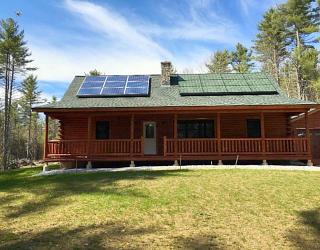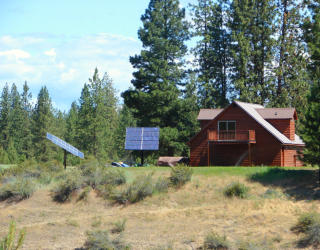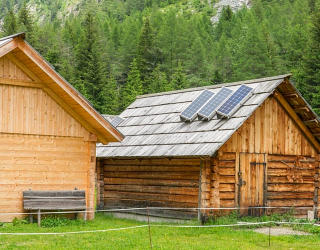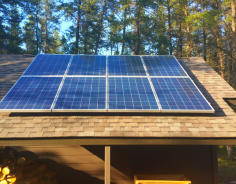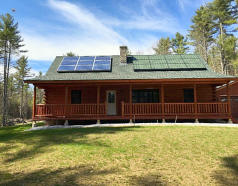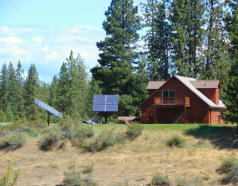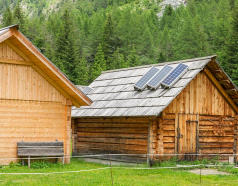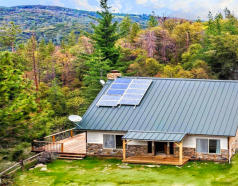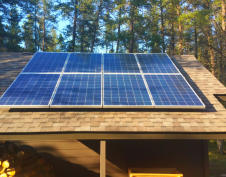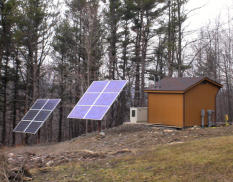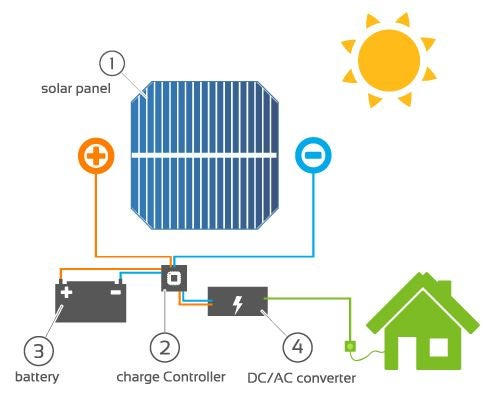
OFF GRID SOLAR


Business Hours
Monday - Friday 9 AM – 7 PM
Saturday 10 AM - 9 PM
Sunday Closed
(435) 522-5618
Providing Solar Power Solutions throughout the USA!
566 N Dixie Drive, St George, UT 84770
What is an off-grid solar system?
While many people think only of solar panels when they hear “off-grid solar”, the reality is that you need to add many other components to get a
functioning off-grid PV system.
A complete off-grid solar system is one that has all the necessary equipment to generate, store, and supply solar energy onsite. As off-grid solar
systems operate without a connection to any external power source, they are also referred to as “standalone solar power systems”.
Unlike other types of solar setups, such as the more common grid-tied solar system, off-grid solar systems rely on batteries to provide power when
the sun isn’t available.
Batteries, however, are costly — much more so than the solar panels they are paired with. The need for ample battery storage in off-grid solar
systems makes them much more expensive than grid-tied solar systems.
What are the different uses of off-grid solar power?
One of the biggest advantages of solar as an energy source is its scalability and modularity, which is the degree to which a system’s components
may be separated and recombined for flexibility and variety in use.
It works at all levels, from small devices such as solar phone chargers, all the way up to a system that can power a factory.
Here are some of the most common applications of off-grid solar:
•
Providing a charge to a portable phone or tablet charger
•
Powering the appliances in an RV
•
Generating electricity for small cabins
•
Powering small energy-efficient homes
It’s worth noting where off-grid solar systems do NOT make sense: where there is easy access to the utility power. This covers situations where one
is looking to power a home in a home in a city, suburb or town.
If that’s you, you can save much more by opting for a grid-tied or hybrid solar panel system — or even just sticking solely to grid power —
depending on the economics of solar in your area.
What equipment does an off-grid solar system require?
Here’s a list of all the equipment required for a functioning off-grid solar system:
•
Solar panels
•
Solar charge controller
•
Solar inverter(s)
•
Solar battery
•
Mounting and racking system
•
Wiring
•
Junction boxes
How to size an off-grid solar system
Deciding on the size of the system you need is an early and absolutely crucial step when it comes to installing an off-grid solar system.
It will affect the kind of equipment you need, how much work the installation will involve, and, of course, the total cost of the project. Solar setup
sizes are based on the amount of power the system needs to provide.
There are two different ways to figure out the number you need, and they are based on:
•
Your current usage
•
Load evaluation
Basing solar setup size on usage
You can use this option if your aim is to maintain your current lifestyle as you switch from grid-tied to off-grid solar. To do this, you can simply refer
to your monthly power bills to determine your electricity usage in kilowatt hours.
You can then size an off-grid system of that size, although you’d want to go a bit bigger — say 10% more — to allow for solar inefficiencies.
Basing solar setup size on load evaluation
The second option is to perform a complete load evaluation to determine how much power you’ll need.
1.
Calculate total electricity usage needs
o
Begin by listing out all the appliances you plan to use, and how many hours you’ll be using each of them. This allows you to calculate the
power consumption of each appliance, as well as your total power consumption over a day.
o
Knowing how many kWh in a day you’ll use will allow you to size your solar panel array, as well the solar battery storage.
2.
Calculate instantaneous load requirements
o
You’ll also have to calculate how many appliances you might run simultaneously. This will help you calculate instantaneous wattage
requirements, which you need to know in order to size the inverter properly (the inverter runs the AC loads).
3.
Decide on battery storage capacity
o
Next, you’ll need to decide how much energy storage you want. Do you want to cover usage for just one day, or do you want to have extra
backup capacity?
o
When it comes to solar battery backup, the rule generally is you'd want enough storage to cover at least 2-3 days of usage during the
highest usage time of year.
4.
Design a system around your number from Steps 1-3
o
Figuring out the sizes of these three crucial components — the solar panels, inverter, and battery storage — is usually enough information
for solar equipment vendors to customize a complete off-grid kit for you.
© 2022 Outdoor Power Innovations, Inc. All Rights Reserved.



Business Hours
Monday - Friday 9 AM – 7 PM
Saturday 10 AM - 9 PM
Sunday Closed
(435) 522-5618
Providing Solar Power Solutions through-
out the USA!
566 N Dixie Dr. St George, UT 84770
© 2022 Outdoor Power Innovations, Inc. All Rights Reserved.








OFF GRID SOLAR
What is an off-grid solar system?
While many people think only of solar panels when
they hear “off-grid solar”, the reality is that you need
to add many other components to get a functioning
off-grid PV system.
A complete off-grid solar system is one that has all the
necessary equipment to generate, store, and supply
solar energy onsite. As off-grid solar systems operate
without a connection to any external power source,
they are also referred to as “standalone solar power
systems”.
Unlike other types of solar setups, such as the more
common grid-tied solar system, off-grid solar systems
rely on batteries to provide power when the sun isn’t
available.
Batteries, however, are costly — much more so than
the solar panels they are paired with. The need for
ample battery storage in off-grid solar systems makes
them much more expensive than grid-tied solar
systems.
What are the different uses of off-grid solar power?
One of the biggest advantages of solar as an energy
source is its scalability and modularity, which is the
degree to which a system’s components may be
separated and recombined for flexibility and variety in
use.
It works at all levels, from small devices such as solar
phone chargers, all the way up to a system that can
power a factory.
Here are some of the most common applications of
off-grid solar:
•
Providing a charge to a portable phone or tablet
charger
•
Powering the appliances in an RV
•
Generating electricity for small cabins
•
Powering small energy-efficient homes
It’s worth noting where off-grid solar systems do NOT
make sense: where there is easy access to the utility
power. This covers situations where one is looking to
power a home in a home in a city, suburb or town.
If that’s you, you can save much more by opting for a
grid-tied or hybrid solar panel system — or even just
sticking solely to grid power — depending on the
economics of solar in your area.
What equipment does an off-grid solar system
require?
Here’s a list of all the equipment required for a
functioning off-grid solar system:
•
Solar panels
•
Solar charge controller
•
Solar inverter(s)
•
Solar battery
•
Mounting and
racking system
•
Wiring
•
Junction boxes
How to size an off-grid solar system
Deciding on the size of the system you need is an
early and absolutely crucial step when it comes to
installing an off-grid solar system.
It will affect the kind of equipment you need, how
much work the installation will involve, and, of course,
the total cost of the project. Solar setup sizes are
based on the amount of power the system needs to
provide.
There are two different ways to figure out the number
you need, and they are based on:
•
Your current usage
•
Load evaluation
Basing solar setup size on usage
You can use this option if your aim is to maintain your
current lifestyle as you switch from grid-tied to off-grid
solar. To do this, you can simply refer to your monthly
power bills to determine your electricity usage in
kilowatt hours.
You can then size an off-grid system of that size,
although you’d want to go a bit bigger — say 10%
more — to allow for solar inefficiencies.
Basing solar setup size on load evaluation
The second option is to perform a complete load
evaluation to determine how much power you’ll need.
1.
Calculate total electricity usage needs
o
Begin by listing out all the appliances you
plan to use, and how many hours you’ll be
using each of them. This allows you to
calculate the power consumption of each
appliance, as well as your total power
consumption over a day.
o
Knowing how many kWh in a day you’ll use
will allow you to size your solar panel array, as
well the solar battery storage.
2.
Calculate instantaneous load requirements
o
You’ll also have to calculate how many
appliances you might run simultaneously. This
will help you calculate instantaneous wattage
requirements, which you need to know in
order to size the inverter properly (the
inverter runs the AC loads).
3.
Decide on battery storage capacity
o
Next, you’ll need to decide how much energy
storage you want. Do you want to cover
usage for just one day, or do you want to have
extra backup capacity?
o
When it comes to solar battery backup, the
rule generally is you'd want enough storage
to cover at least 2-3 days of usage during the
highest usage time of year.
4.
Design a system around your number from Steps
1-3
o
Figuring out the sizes of these three crucial
components — the solar panels, inverter, and
battery storage — is usually enough
information for solar equipment vendors to
customize a complete off-grid kit for you.






